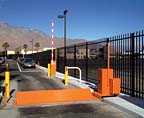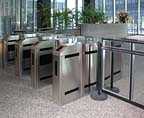The Bs: Barriers, Booths, Badges

One application where new technology is appreciated is on government and military facilities.
An example is Sky Watch from New Heights Manufacturing of Ellaville, Ga. Equipment from the firm is on duty in more than 60 U.S. military facilities and U.S. Border Patrol installations.
Sky Watch is a mobile tower with a totally enclosed heated and air-conditioned cab/booth that can lift a security officer up 24 feet into the air.
Another source, Par-Kut, Harrison Township, Mich., has – among its extensive booth models, a bullet-resisting two-story guard tower. Par-Kut also has a two-story guard booth that lets a security officer go to the second level to look around a parking lot or into a area not seen from the ground. There is a desire by some security operations to extend the "reach" of officers on post so that they can see farther without leaving the booth or tower.

Blocking vehicles
Specially designed to provide access control to very high security areas such as military, commercial, government sites or any other site that may be targeted for terrorism, the 10-foot wide RSB-78 Vehicle Blocker from Automated Control Systems of Port Washington, N.Y., allows for multiple systems to be installed side–by-side for wider roadways. Certified K-12 Rating, emergency opening in less than two seconds, it is shallow mounted in less that 18 inches and is flexible enough to integrate with all card reader systems.There also is need for special access controls at facilities that are not as hardened as military bases.
For example, the Great Valley School District in Malvern, Pa., wanted to add another layer of safety for students, teachers and staff with a better way to monitor visits by parents, contractors, volunteers and other guests.
For years, schools in this Philadelphia suburb relied on hand-written logbooks whose carbon-copy records were cumbersome, unmanageable and often illegible. Not only did administrators have trouble tracking arrivals and departures, but they incurred additional expenses if guests left with their paper ID badges still in the expensive plastic casing.
The school district needed a reliable, efficient system that accurately recorded and tracked visitors, was easy to use and was affordable. The Avery Photo ID System (Brea, Calif.) provided that solution. The system records visitor information, prints color photo ID badges and keeps a digital record of visitors. The small camera and its accompanying PC that records and stores information also lends a more professional appearance to school hallways.
Piloted at General Wayne Elementary School, the system was an instant success and installed in the rest of the school facilities.
With the new system in place at schools and administrative offices throughout the district, visitors can now sign-in at any of the locations. In less than a minute, visitors receive a high-quality, color photo ID badge. It captures an image of the visitor, his or her name and where the person is going in the facility. Data are stored in a single central log. Accompanying software allows officials to instantly request information about visitors they deem necessary from the database.
Great Valley school and law enforcement officials agreed that having a visual record was more likely to encourage visitors to provide accurate personal information and refrain from causing problems. If a visitor were involved in an incident, identifying the individual with the photo ID system will be much easier than sifting through logbooks.
The system also enhanced sign-ins. Since the software stores photos and record, returning guest are able to sign in quickly and get a badge, with virtually no waiting.

stop different types and sizes of vehicles going at varied speeds.
Barcode tracking
One unique feature of this particular system is its ID badge barcode, which is scanned when a visitor enters and leaves a facility. Since the digital log records the time of visits, administrators can check the system to confirm that guests have departed if a school must be evacuated. The school district now has enhanced accountability of the various types of visitors to its public buildings. And, because the school color-codes badges by day of the week, a teacher or administrator can see at a glance and at a distance if a visitor has signed in properly.Banks always understood the need for securing their money, securities, paperwork and IT systems but they were some of the first that understood the need for ensuring that only authorized users can pass through their entrances. The physical barriers produced by Optical Portals (Automated Control Systems) eliminate the need for excessive audible alarms. Today they are available in the standard 380 series or the ADA compliant 390 series. Optical Portals operate from the closed position and the glass panels open only upon receiving a valid signal from a card reader or biometric systems.
Guard tour systems also are hot, especially RFID technology such as ProxiGuard of Miami, Fla., One new feature is the ability to download information via USB.

Mandated by the NRC for U.S. nuclear power plants, blast-resistant booths are now procured as a part of advanced security programs at facilities all over the United States. Bovis Lend Lease, a major New York project management and construction services company currently in an “on-call contract” with the New York City Economic Development Corporation, is using new ballistic resistant guard booths.
Looking for a reprint of this article?
From high-res PDFs to custom plaques, order your copy today!




